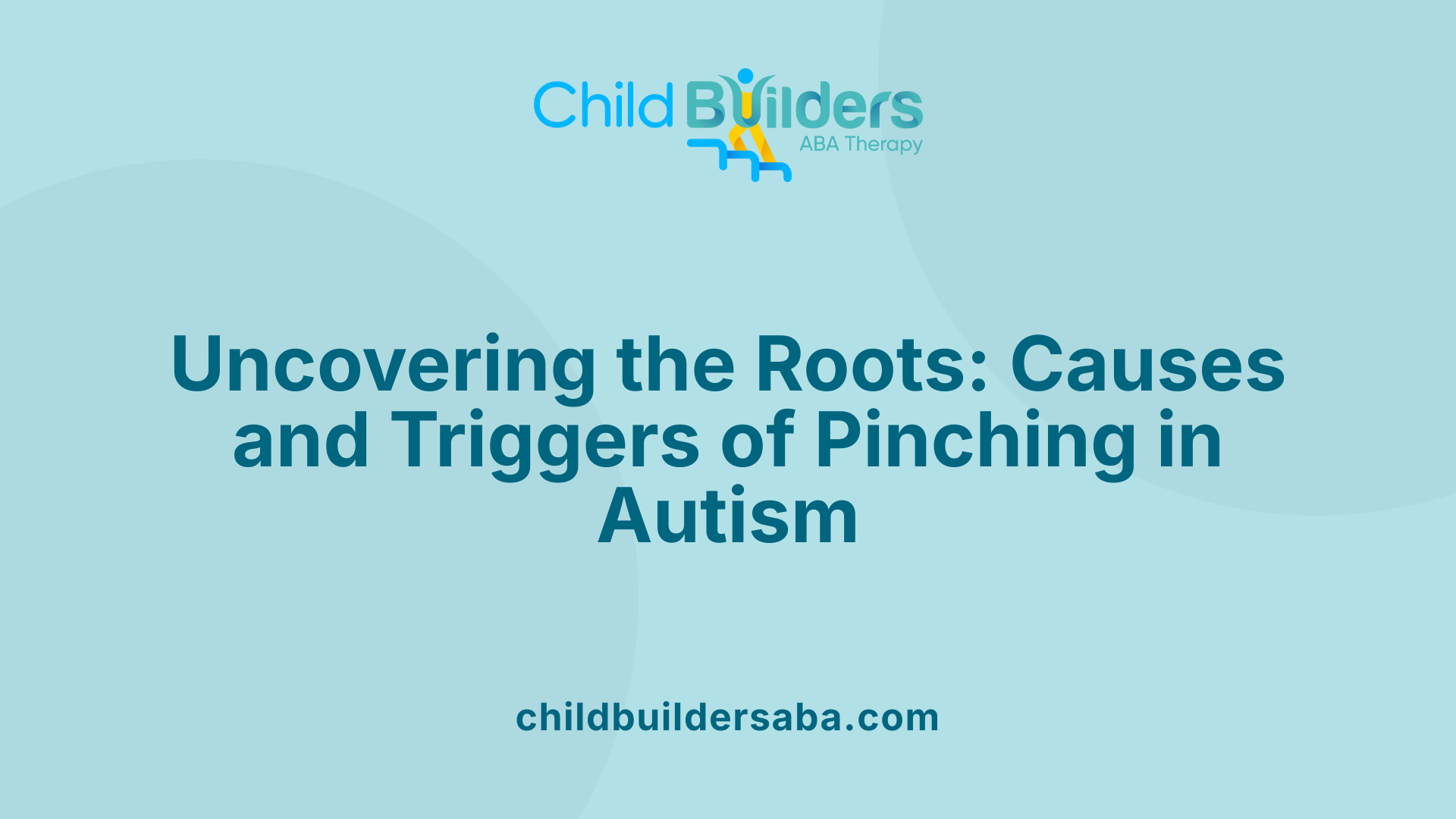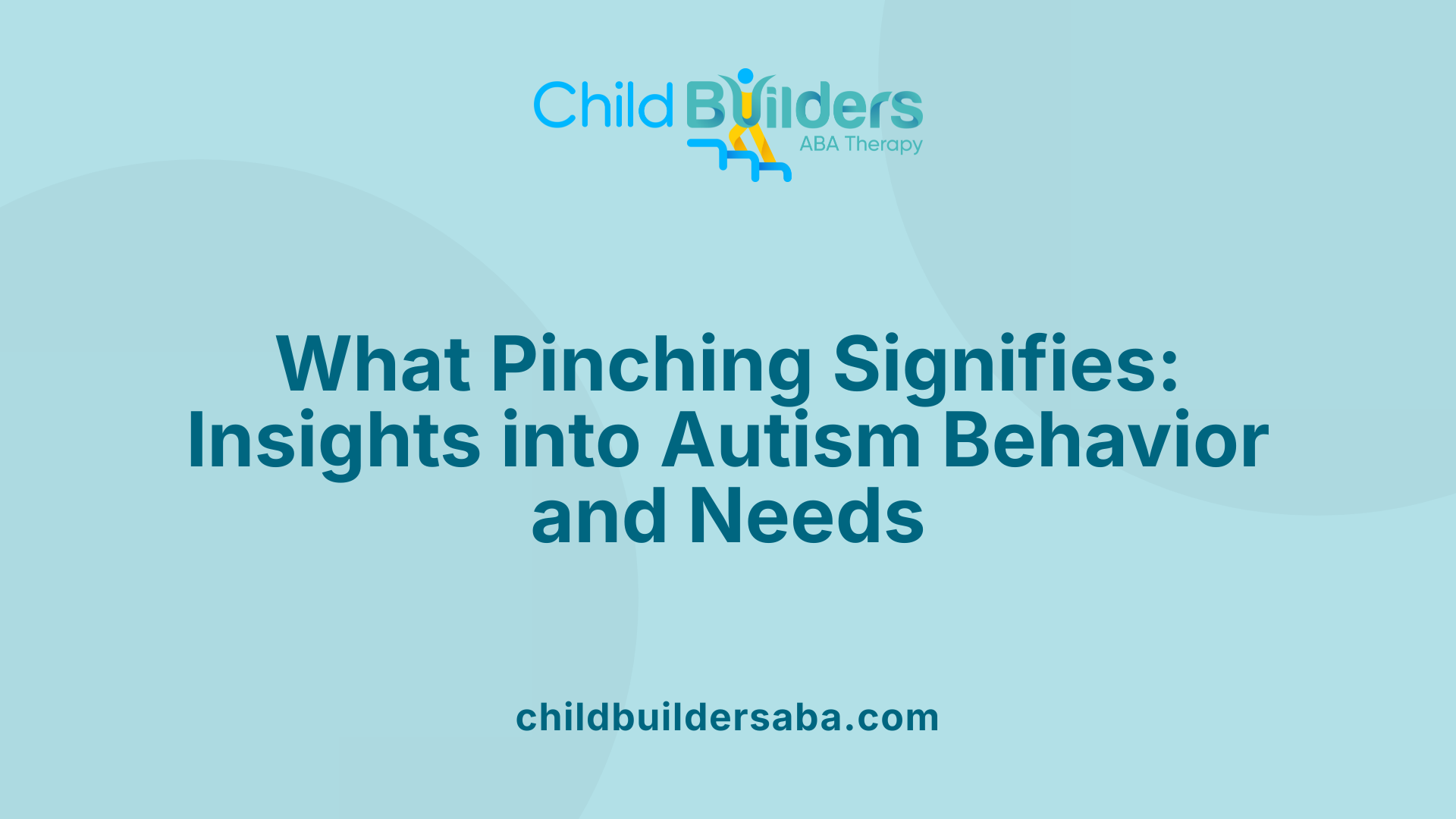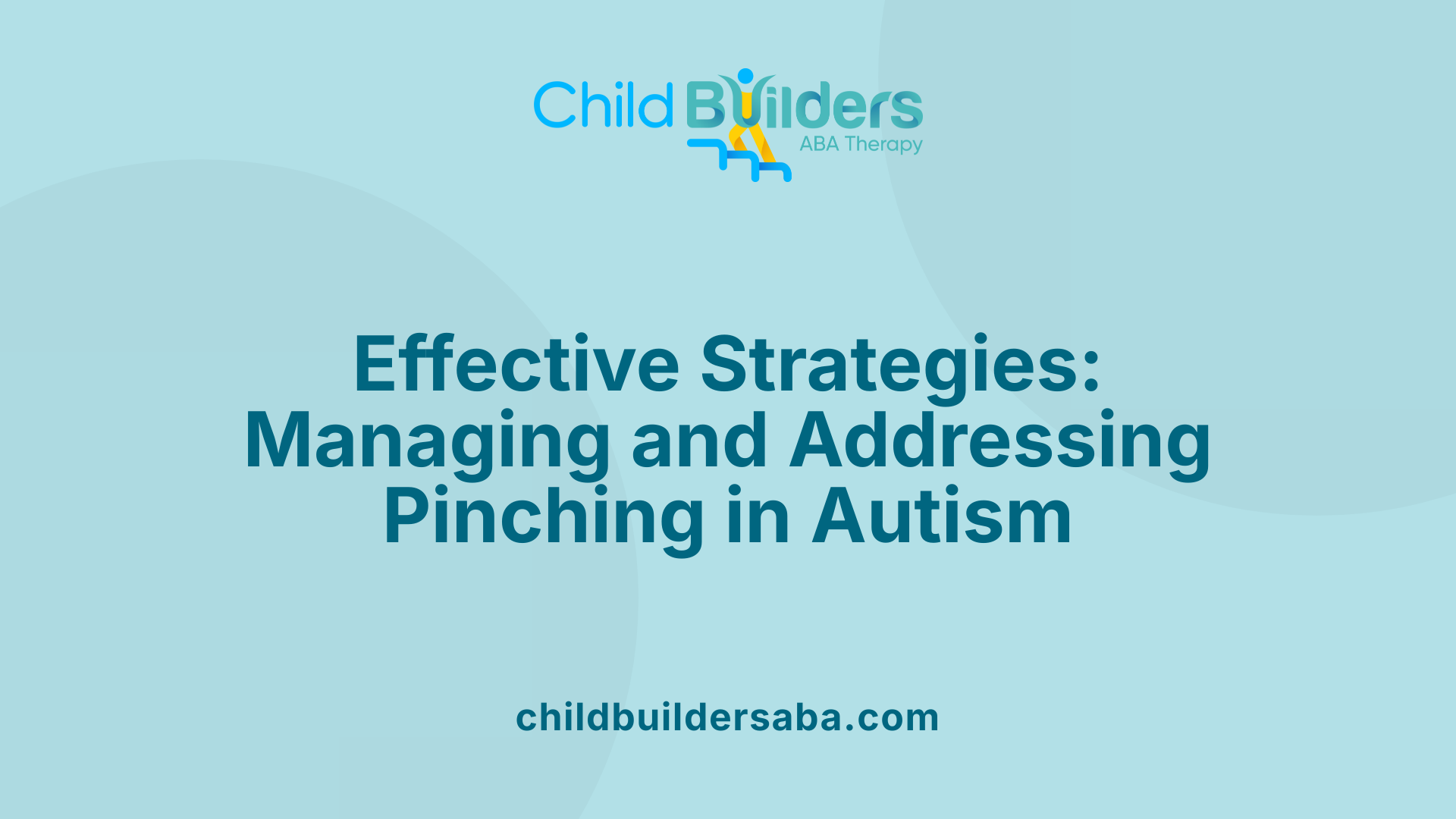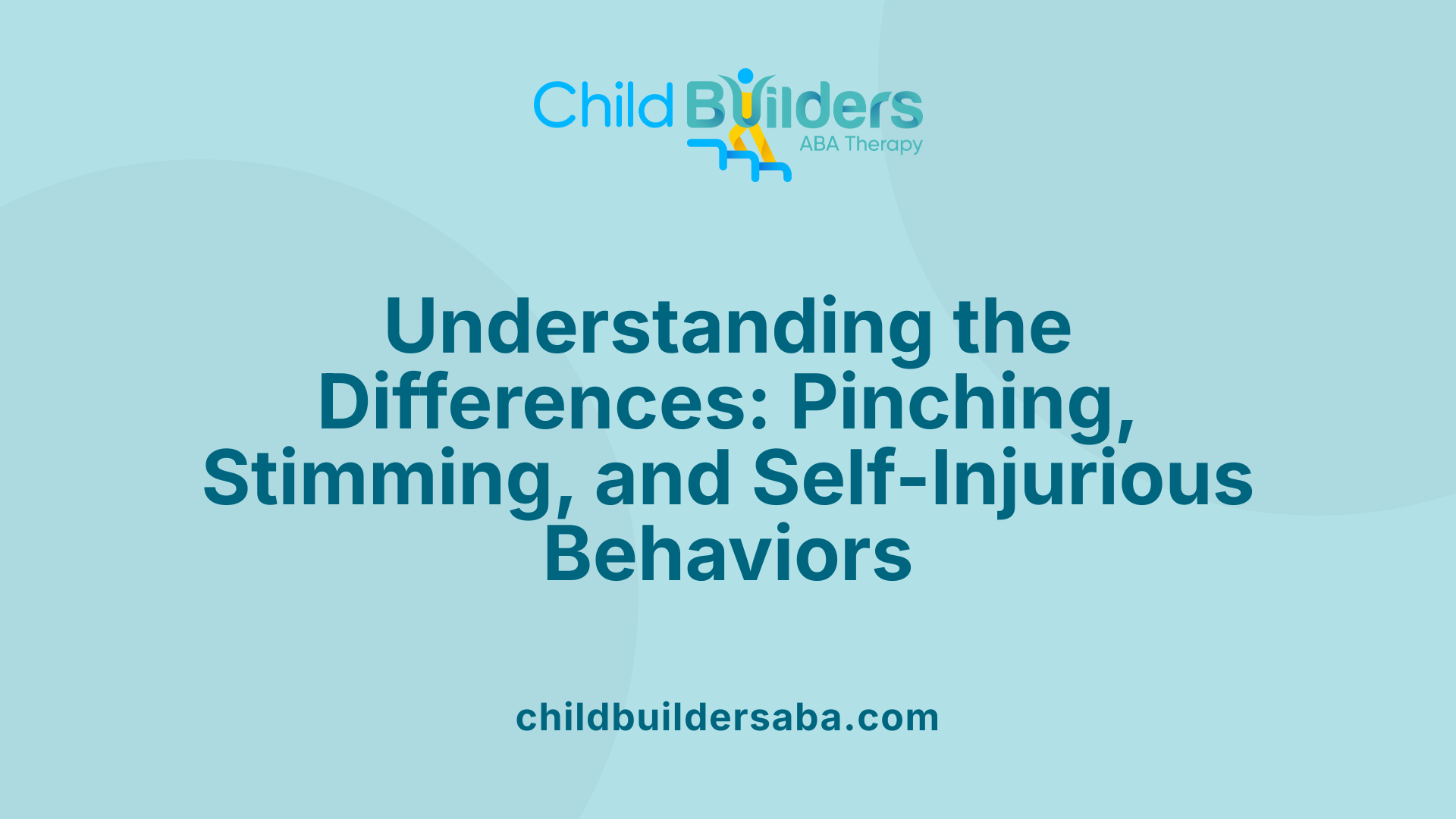What Is Autism Pinching Behavior?

Introduction to Autism-Related Behaviors
Autism spectrum disorder (ASD) manifests through a variety of behaviors, some of which can be challenging for caregivers, educators, and the individuals themselves. Among these behaviors, pinching is a common but often misunderstood action. To support children and adults with autism effectively, it is crucial to understand the nature, causes, and management strategies related to pinching and similar behaviors.
What Is Autism Pinching Behavior?
What is autism pinching behavior?
Autism pinching behavior often manifests as a form of self-stimulation or a way to communicate when children with autism experience sensory overload or frustration. Rather than being a malicious act, pinching in this context is usually a response to sensory needs or difficulty expressing feelings.
Children with autism may pinch themselves or others as an attempt to release excess sensory energy or to seek sensory input that they find calming or stimulating. This behavior can also serve as a way to communicate discomfort, anxiety, or other needs when verbal communication skills are limited.
Understanding this behavior involves recognizing that it is not meant to harm but rather a way for the child to self-regulate or cope with overwhelming sensory or emotional stimuli. It is often triggered by sensory sensitivities, such as heightened tactile awareness, or emotional distress linked to communication challenges.
Managing autism pinching involves providing gentle sensory input or alternative activities that satisfy the child's sensory needs. For example, offering fidget toys or sensory bins can help redirect the behavior.
Responding consistently and calmly is crucial. Using visual supports or social stories can clarify appropriate behaviors and reduce frustration.
Preventative strategies include creating a sensory-friendly environment, teaching communication skills to express needs more effectively, and maintaining a predictable routine to lower stress levels.
In essence, understanding the motives behind pinching and using proactive, supportive approaches can help diminish this behavior and foster better self-regulation in children with autism.
Causes and Triggers of Pinching Behavior in Autism

What are the causes and triggers of pinching behavior in autistic individuals?
Pinching behavior among autistic individuals can stem from a variety of underlying causes and triggers. Recognizing these factors is crucial for effective management and support.
One prominent trigger is sensory overload. Many autistic people experience tactile sensitivities or a heightened need for sensory input. When overwhelmed by external stimuli or seeking additional sensory stimulation, they might resort to pinching as a form of self-stimulation or sensory seeking.
Communication difficulties are another significant cause. When an individual cannot easily express their needs, feelings, or frustrations verbally, they may use pinching as an alternative way to communicate distress or discomfort. This non-verbal cue can be their way of signaling, "I need help" or "I'm overwhelmed."
Emotional distress, such as anxiety, frustration, or feelings of being overwhelmed, often triggers pinching behavior. When faced with complex or unfamiliar situations they cannot process efficiently, some children may act out physically as a way to cope or alert caregivers.
Physical discomfort or medical issues can also prompt pinching. Conditions like ear infections, dental pain, or general bodily discomfort may lead children to seek relief through pinching, which might temporarily distract from or alleviates their discomfort.
Finally, many individuals engage in pinching as a form of self-regulation. Similar to other self-injurious behaviors, pinching can provide sensory relief or help manage internal discomfort, acting as an attempt to cope with overwhelming feelings or sensations.
Understanding these triggers allows caregivers and professionals to tailor interventions that address the root causes, reducing the frequency and severity of pinching behaviors.
Significance and Implications of Pinching in Autism

What is the significance of pinching behavior in autism?
Pinching behavior in autism is often a manifestation of underlying sensory processing challenges, communication difficulties, or emotional regulation issues. It can serve as a way for individuals to self-soothe, release excess energy, or seek sensory input, especially when they have difficulty expressing needs verbally.
Many children with autism may resort to pinching as a form of non-verbal communication to signal discomfort, frustration, or a need for attention. It can also be a response to sensory overload or under-stimulation, where the act of pinching momentarily provides relief or stimulation.
Understanding the reasons behind this behavior is crucial for providing appropriate support. This involves carefully observing the situations or triggers that lead to pinching, which can reveal whether the behavior is driven by sensory, emotional, or communicative needs.
Intervention strategies typically focus on addressing the root causes. For example, offering sensory regulation tools like textured toys, calming environmental modifications, or teaching alternative ways to communicate can significantly reduce pinching episodes.
Supporting individuals with safe outlets for energy and sensory regulation can help lessen the frequency of pinching. Providing clear, visual communication aids or social stories can empower children to express their needs in more appropriate ways, leading to better emotional regulation and a decrease in self-injurious behaviors.
In summary, pinching in autism is not just a repetitive act but a meaningful signal that highlights underlying needs. Recognizing and addressing these needs with tailored strategies can promote safety, reduce distress, and enhance overall well-being for children on the spectrum.
Managing and Addressing Pinching in Autism

How can pinching behavior be managed and addressed in autistic individuals?
Pinching is a common challenge among children and adults with autism, often linked to sensory processing issues, frustration, or communication difficulties. Effectively managing this behavior requires a comprehensive approach.
First, identifying triggers is essential. Many instances of pinching occur due to sensory overload, frustration from not being able to communicate needs, or environmental stressors. Observing the individual and keeping a behavior diary can help pinpoint specific situations or sensory stimuli that lead to pinching.
Using communication aids and visual supports can significantly reduce the occurrence of pinching. Tools such as picture exchange communication systems (PECS), communication boards, or sign language enable individuals to express their wants and needs more clearly. Providing alternative ways to communicate diminishes feelings of frustration that may lead to self-injurious behaviors.
Behavioral interventions are highly effective. Techniques like Applied Behavior Analysis (ABA) focus on reinforcing positive behaviors and teaching coping skills. Functional behavior assessments (FBA) help determine the purpose behind pinching, guiding tailored intervention strategies. Reward systems involving praise or preferred activities motivate individuals to adopt appropriate behaviors.
Environmental modifications and sensory considerations play a vital role. Creating a sensory-friendly environment—such as reducing loud noises, bright lights, or overwhelming textures—can decrease sensory overload. Offering sensory tools like fidget spinners, textured toys, or calming weighted blankets can help individuals self-regulate and prevent distress.
Seeking professional guidance completes the intervention process. Occupational therapists, behavioral specialists, and medical professionals can develop personalized plans that address underlying issues and incorporate therapies such as sensory integration or counseling. Regular reviews and adjustments ensure that strategies remain effective.
Overall, managing pinching in autism involves understanding the individual's triggers, supporting communication, creating a calming environment, and applying structured behavioral techniques, all under professional supervision. This comprehensive approach promotes safety, reduces distress, and enhances the individual's quality of life.
Therapeutic Strategies and Interventions for Pinching Behavior
What interventions or therapeutic options are available for addressing pinching behavior?
Addressing pinching in children with autism requires a thoughtful approach that first focuses on understanding the reasons behind the behavior. Pinching may serve functions such as sensory seeking, frustration relief, or communication of needs. By identifying these underlying causes, caregivers and professionals can choose effective strategies.
Sensory-based therapies are often helpful. These include deep pressure techniques, where weighted blankets, squeeze machines, or tactile toys like stress balls can provide calming input. Such sensory input helps regulate the child's sensory system, reducing the impulse to pinch.
Behavioral modification is another crucial part of intervention. Using visual supports such as social stories or communication boards can teach children alternative ways to express themselves. Positive reinforcement—praising or rewarding appropriate behavior—encourages children to adopt more suitable ways to communicate or self-soothe.
Occupational therapy plays a vital role by focusing on sensory integration and developing self-regulation skills. Therapists can implement personalized activities that help children manage sensory overload and reduce the need for behaviors like pinching.
Consistent, calm reactions from caregivers and staff are essential. Recognizing potential triggers, such as overstimulation or frustration, allows for proactive measures before the behavior occurs.
Seeking advice from medical and behavioral professionals is recommended for tailored interventions. Professionals can evaluate the child's specific needs and develop comprehensive treatment plans that include behavioral therapy, sensory interventions, and possibly medication if appropriate.
Overall, a multi-disciplinary approach combining sensory regulation, communication skill-building, and behavioral strategies provides the best chances for reducing pinching and promoting healthier coping mechanisms.
| Intervention Type | Examples | Goals |
|---|---|---|
| Sensory therapies | Deep pressure, tactile input | Calms overstimulated sensory systems |
| Behavioral strategies | Visual supports, social stories | Teach appropriate behaviors, communication skills |
| Occupational therapy | Sensory integration activities | Promote self-regulation and sensory processing |
| Professional consultation | Medical or behavioral assessment | Implement tailored, effective protection plan |
Implementing these interventions with patience and consistency can significantly improve the child's ability to manage sensory sensitivities and emotional needs, reducing the occurrence of pinching behaviors.
Recognizing and Differentiating Harmful Behaviors
How can caregivers recognize problematic or harmful behaviors such as pinching?
Caregivers play a vital role in identifying behaviors that may signal distress or pose safety concerns. Noticing problematic behaviors like pinching involves careful observation of how, when, and why the behavior occurs. Signs that pinching is problematic include its frequency, intensity, and whether it results in injury or does not decrease despite attempts to intervene.
Children with autism may use pinching as a way to communicate, self-soothe, or seek sensory input. It often intensifies when the child is overwhelmed, anxious, or unable to express their needs appropriately. Caregivers should be alert for behaviors that seem repetitive, serve a purpose related to discomfort, or are triggered by specific environmental factors.
Monitoring these behaviors involves tracking their occurrence, understanding associated signs of distress such as self-injury or aggression, and consulting professionals for tailored strategies. Recognizing warning signs early helps in implementing interventions that focus on teaching alternative communication methods, reducing triggers, and ensuring safety. If pinching leads to injury or occurs frequently, seeking guidance from specialists like occupational therapists or behavior analysts is recommended to develop effective management plans.
Differentiating Pinching from Other Autism-Related Behaviors
 Autistic children often exhibit a range of behaviors that serve different purposes and have distinct characteristics. Understanding how pinching differs from other behaviors such as stimming and self-injury is important for effective management.
Autistic children often exhibit a range of behaviors that serve different purposes and have distinct characteristics. Understanding how pinching differs from other behaviors such as stimming and self-injury is important for effective management.
How does pinching differ from other autism-related behaviors like stimming or self-injury?
Pinching involves applying pressure with fingers or hands, which can cause pain or discomfort to oneself or others. It is often linked to sensory seeking, frustration, or communication difficulties. In contrast, stimming behaviors, such as hand-flapping, rocking, or humming, are typically repetitive actions that help regulate sensory input, reduce anxiety, or provide self-soothing, generally without causing harm.
Self-injurious behaviors like head-banging, biting, or skin-picking tend to be more severe and deliberate efforts to cope with overwhelming emotional or sensory states. These actions can lead to injury and often indicate higher levels of distress or frustration.
Physical harm and injury potential
While stimming usually does not result in physical harm, pinching can cause skin bruising or pain, especially if repeated or forceful. Self-injurious behaviors are more likely to result in tissue damage or injury, requiring immediate professional attention if they occur frequently or severely.
Behavioral purpose and function
The purpose behind these behaviors varies. Pinching may serve as a form of sensory input or a way to gain attention. Stimming functions mainly to manage sensory overload or reduce anxiety without harmful effects. Self-injury may be a last resort to release intense stress or emotional pain.
Understanding these differences helps caregivers and professionals develop targeted strategies for intervention. Replacing harmful behaviors with appropriate coping mechanisms, such as communication tools or sensory activities, reduces risks and supports the child's well-being.
| Behavior Type | Common Actions | Harm Potential | Typical Function | Intervention Approach |
|---|---|---|---|---|
| Pinching | Applying pressure, squeezing | Moderate — skin bruising, pain | Sensory seeking, frustration | Teaching alternative communication, sensory regulation strategies |
| Stimming | Hand flapping, rocking, humming | Low, unless self-injurious | Self-calming, sensory management | Encouraging safe stim behaviors, environmental modifications |
| Self-Injury | Head-banging, biting, skin-picking | High — tissue damage, injury | Emotional distress, sensory overload | Professional therapy, behavior modification, environmental safety |
Understanding these distinctions enables a tailored response that promotes safety and comfort for children with autism.
Supporting Individuals with Autism and Behavioral Challenges
Understanding and managing behaviors like pinching requires a comprehensive approach that considers the unique sensory, emotional, and communication needs of each individual. By implementing targeted strategies, offering appropriate support, and seeking professional guidance, caregivers can help reduce harmful behaviors and promote positive development. Patience, consistency, and a supportive environment are key to helping children and adults on the autism spectrum achieve better self-regulation and quality of life.
References
- How to Resolve Biting in Children with Autism - Dr. Mary Barbera
- Distressed behaviour - a guide for all audiences
- Help our child who has autism he won't stop pinching or hitting!
- How to Handle Common Aggressive Behaviour for Children with ...
- Hand Flapping and Stimming in Autism
- Self-injurious behaviour - a guide for all audiences
- Managing Autism Pinching Behavior: A Guide - NeuroLaunch.com



.jpg)

































































































